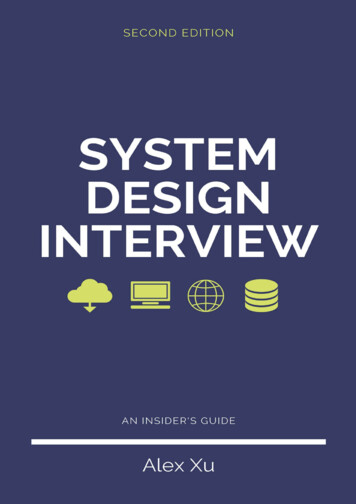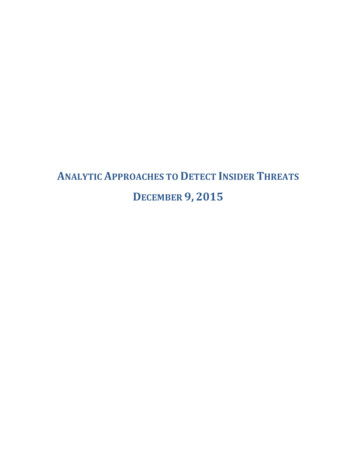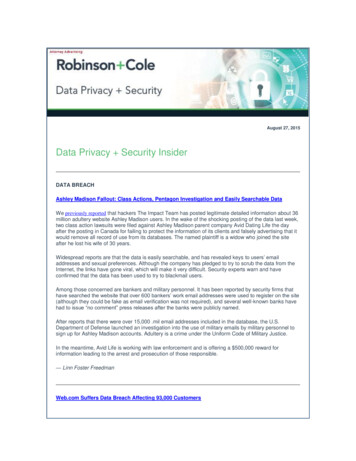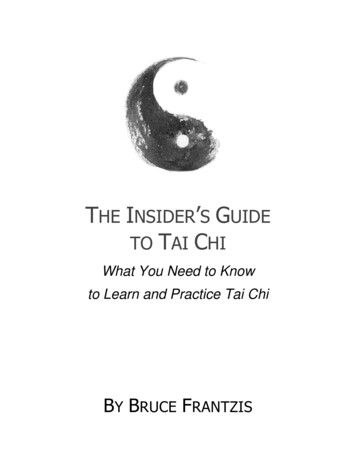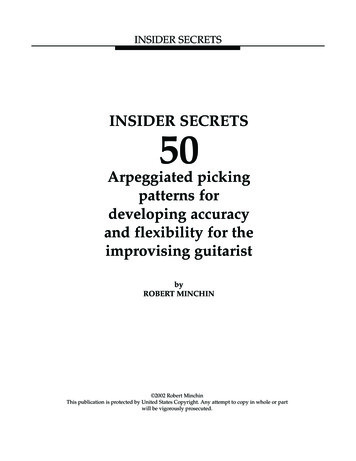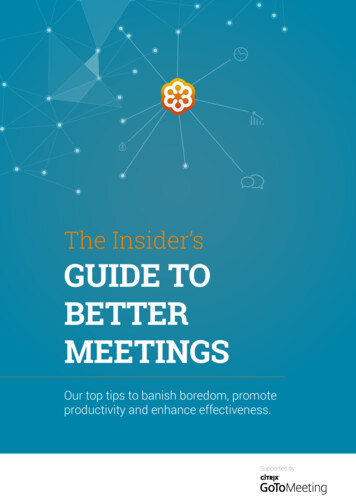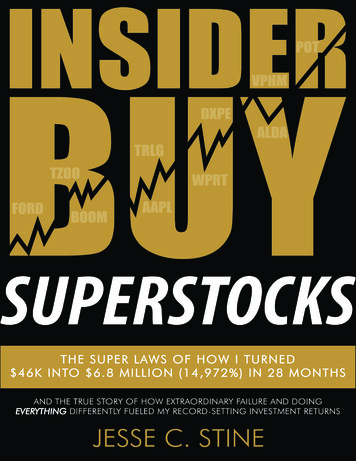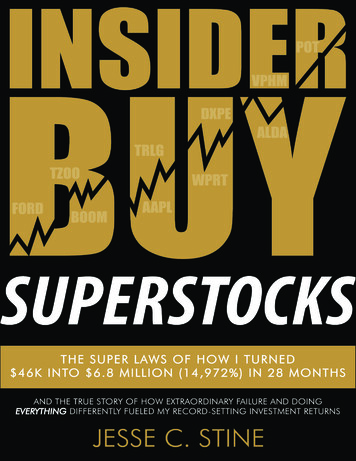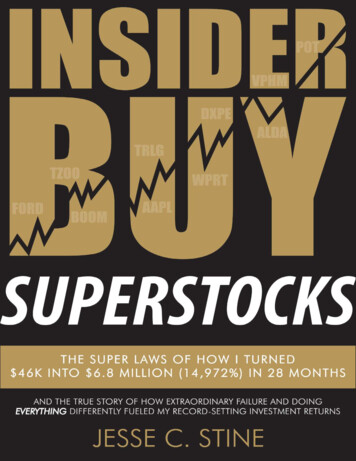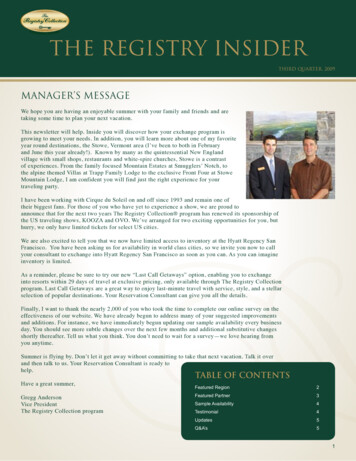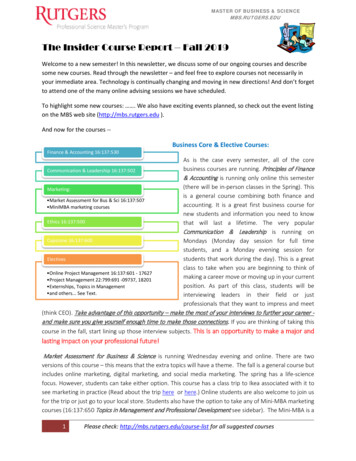
Transcription
Risk DisclosureFutures and forex trading contains substantial risk and is not for every investor. An investorcould potentially lose all or more than the initial investment. Risk capital is money that canbe lost without jeopardizing ones’ financial security or life style. Only risk capital should beused for trading and only those with sufficient risk capital should consider trading. Pastperformance is not necessarily indicative of future results.Hypothetical Performance DisclosureHypothetical performance results have many inherent limitations, some of which aredescribed below. No representation is being made that any account will or is likely toachieve profits or losses similar to those shown; in fact, there are frequently sharpdifferences between hypothetical performance results and the actual results subsequentlyachieved by any particular trading program. One of the limitations of hypotheticalperformance results is that they are generally prepared with the benefit of hindsight. Inaddition, hypothetical trading does not involve financial risk, and no hypothetical tradingrecord can completely account for the impact of financial risk of actual trading. for example,the ability to withstand losses or to adhere to a particular trading program in spite of tradinglosses are material points which can also adversely affect actual trading results. There arenumerous other factors related to the markets in general or to the implementation of anyspecific trading program which cannot be fully accounted for in the preparation ofhypothetical performance results and all which can adversely affect trading results. Thisbook is for educational purposes only and the opinions expressed are those of the authoronly. All trades presented should be considered hypothetical. All the trades are not traded ina live account.TestimonialsTestimonials appearing in this publication may not be representative of other clients orcustomers and is not a guarantee of future performance or success.
ObsahIntroduction. 8My story. 8What you will learn . 9Why don't I keep it secret? . 9Important notice . 10Price Action . 11Why does the price move?. 11Who moves the price? . 12Indicators . 14How to spot institutional activity with Price Action . 15Sideways price action area . 15Aggressive initiation activity . 17Strong rejection (of higher or lower prices) . 19The complete picture . 21What timeframes to use to spot institutional activity . 22Price Action Trading Strategies . 22Strategy 1: Support becoming resistance (and vice versa) . 23Strategy 2: Open-drive . 25Strategy 3: AB CD. 28Strategy 4: Session Open . 32Strategy 5: Daily Open . 33Strategy 6: Daily/weekly high and low . 34Strong or weak highs/lows . 37Failed auction . 43Volume Profile . 49
Why are volumes so important? . 49Where to get Volume Profile . 50Where to get data . 51Volume Profile: Point of control . 52Volume Profile: Different profiles and their application . 54“D-profile“ . 54“P-profile“. 56“b-profile“. 57“Thin profile“ . 58Flexible Volume Profile. 59Volume Profile trading setups . 61Volume Setup #1: Volume accumulation setup . 62Volume Setup #2: Trend setup . 68Volume Setup #3: Rejection Setup . 73Reversal trade. 76Finding your style . 78Intraday trading . 78Trading instruments for intraday trades . 78Stop-loss and Profit Target for intraday trades. 79Swing Trading . 80Trading instruments for swing trades . 80Stop-loss and Profit Target for swing trades . 81Long-term investments . 82Trading instruments for long-term investments. 82Stop-loss and Profit Target for long-term investments . 83What instruments to trade? . 85
Correlation & Excessive risk exposure . 85Being overwhelmed . 87Choosing the right currency pair . 87Steps to chose the right trading instruments . 89Major currency characteristics . 90My favorite trading instruments . 92BONUS: Best cryptocurrencies to trade . 92Macroeconomic news . 94Tip #1: Don't try to predict the news or the market's reaction to it. 95Tip #2: Keep track of macro news release times . 95Tip #3: How to deal with unexpected news . 96Tip #4: The importance and possible impact of different types of macroeconomic news . 971. Weak red news . 982. Standard red news . 983. Monster red news . 99Tip #5: Which news affects which fx pair . 100Tip #6: Don't trade during significant news release. 101Tip #7: Ways to quit your trade before a significant news release . 102Tip #8: When to start trading again after the news release . 104Tip #9: Re-enter a trade after a macro event has passed . 104Tip #10: Adjust your trading to the post-news reaction . 106Market analysis from A to Z . 107Intraday trading analysis . 107Swing trading and long-term investment analysis . 109Position management . 111Profit Target . 111
Fixed Profit Target: . 111Volume-based Profit Target: . 111Stop-loss placement . 113Fixed Stop-loss . 113Volume-based Stop-loss . 114Volume-based Stop-loss: Alternative SL approach . 116Stop-loss management. 118Quitting the position earlier . 120Money management . 122How much to risk per trade . 122Risk Reward Ratio (RRR) . 123Position sizing . 125Correlation. 126Trading psychology. 128Four kinds of trades. 128Good winning trade. 128Bad winning trade . 129Good losing trade . 129Bad losing trade . 130How to never break a rule . 130Cycle of doom and despair . 131How to handle winning . 132How to handle losing . 133How to deal with a standard drawdown . 133How to deal with an excessive drawdown . 133How to get back on the right track . 134
Backtesting & getting started . 136Phase 1: Rough backtest . 136Phase 2: Thorough backtest . 137Phase 3: Micro trading . 137Phase 4: Half positions . 138Phase 5: full positions. 139Trading journal . 139The 10 most common trading mistakes you should avoid . 141#1 Using indicators . 141#2 Martingale . 141#3 Believing too much in one trade . 143#4 Using too big positions . 143#5 Never being able to admit you were wrong . 143#6 Not using Stop-loss . 144#7 Entering a position without a plan . 144#8 Following other people’s ideas blindly . 145#9 Jumping from strategy to strategy . 145#10 Sticking with a bad broker . 145BONUS: How I manage my intraday trades. 147How I enter my trades . 147Where to place your Stop-loss & Profit Target . 149Trailing your Stop-loss . 151Tested levels . 152How long should you hold a position? . 155Gap at market open . 155Old trading levels. 156
Take all valid trade setups . 157Real trades . 159Intraday trades . 159Trades based on Setup #1: Volume accumulation setup . 159Trades based on Setup #2: Trend setup. 164Trades based on Setup #3: Rejection setup . 171Reversal trades . 175Swing trades . 180Swing trades based on Setup #1: Volume accumulation setup . 181Swing trades based on Setup #2: Trend setup . 182Swing trades based on Setup #3: Rejection setup . 183Putting it together . 184Accelerate Your Learning . 185Just a few testimonials on the course . 188
IntroductionMy storyHello, my name is Dale, and I am a full-time trader since 2008. I have always been verypassionate about economics, finance, and trading. I got my university degree in finance,before becoming a certified portfolio manager, investment manager, as well as getting myfinancial derivatives certification. I am proud to say that unlike most of all the trading"gurus," I actually have a proper education and certification. This is, of course, thanks to myparents who supported me enormously in my studies and who helped me at the start of mycareer.Fresh out of college, I started to work as a market analyst for a major brokerage. Most wouldbe grateful to have this position right out of college, but I didn’t really feel it this way. I hadtwo problems with this job. The first one was that I don’t like having a boss who tells me whatto do. I always studied hard to be independent not an employee. The second reason was thatI didn’t like how the company treated their customers. I think this is an issue with most forexbrokers. They don’t really care if their clients make money or not. They are selfish and focusprimarily on their fees. They feel no responsibility, and they don’t care about their clients bestinterest. I didn’t like being a tool in such a company, so I left.After I quit my job, I focused all my efforts towards trading. This was my 100% focus; testingall sorts of different trading strategies, trying different trading approaches, backtesting variouspatterns and anything else you can think of for 12-15 hours every day.I was trading various instruments and using many different trading styles. I was trading stocks,investment certificates, and automated trading systems. Currently, my primary focus is onmanual forex trading.When I started trading forex, I was under the impression that I needed to find a Holy Grailwhich would make me a big pile of money quickly. I was searching for this Holy Grail amongvarious trading indicators. Needless to say that I sucked. I tried most of the standard indicatorswith many different settings, but nothing really worked. At least not in the long run.
My first tangible success was when I finally got rid of all the indicators and started anew withsimple Price Action. For the first time, I felt I was getting somewhere! The big "eurekamoment" came when I combined Price Action with Volume Profile. This was when I started tosee a consistent edge and consistent profitability.What you will learnWhen I was writing this book, my goal was to give you the book I wish somebody gave me 10years ago, when I started. A book which would save me all the time spent in dead ends, all thetime spent researching and a book that would guide me through the complicated world oftrading, leading me the right way and teaching me all the important aspect of trading.In this book you will learn: How to work with Price Action Price Action strategies that you can immediately put to use How Volume Profile works My favorite Volume Profile strategies How to find your own trading style and what are the best trading instruments to trade How to manage trading around macroeconomic news How to do your market analysis from A to Z How to manage your positions How to do a proper money management How to deal with trading psychology How to do a proper backtest and how to get started with trading your backtestedstrategies What are the most common trading mistakes and how to avoid them The exact ways and rules I apply to my own tradingYou will learn all this in a simple, poignant way along with many examples and pictures.Why don't I keep it secret?Let me address one pretty important question most people have. In fact, you wouldn‘t reallybe a smart investor if you weren‘t skeptical about this. The thing is: Why would I reveal to you
my working trading strategies? Why not keep it to myself? Why not keep it secret, if it is reallythat good?I have seen so many scammers in this industry. There are so many people who don't have anyfinancial education, no certification, no real knowledge of the markets and still they placethemselves in a position of a "guru." Still, they don't care if the people who pay for their servicefail or not. The brokerage company I worked for before wasn‘t different.I am personally strongly against such practices. I want to do things differently and actually helppeople, and giving you a helping hand doesn‘t hurt me in any way. Do you know how manypeople like you and me trade currencies? How much volumes do we control? It is only 3.5%.Only 3.5% of daily forex volume is controlled by retail traders (statistics from Bank forInternational Settlements). The rest is institutions.Based on this fact, helping you and other retail traders like you with their trading can‘t haveany impact on the market, and it can‘t endanger me and my trading strategy. So I don‘t thinkthere is a reason not to share. If you are willing to learn and you are willing put some workinto improving your trading, then I am more than glad to share my knowledge.Important noticeThis is not a “get rich quick“ magic guide. I won‘t lie to you and make any false promises. Ittakes time and hard work to learn and master trading and the Volume Profile. If you arelooking for a magic formula, you are reading the wrong book. I really can‘t make any promises.I will show you what I do and what works for me. That‘s it. I can‘t guarantee that it will workfor you too. Everybody is different, and my trading style may not suit everyone. That's a fact.What is also a fact though, is that this is the best trading approach I came across in my decadelong trading career. What I am about to teach you with this book is the best I know.So, if you don‘t mind that I won‘t be giving you a “magic pill,“ (as it doesn’t exist) then let‘smove on to the first chapter!
Price ActionPrice Action is the art of understanding the naked charts without any indicator. It is the firstthing I recommend to learn before jumping into anything else. It is the corner-stone uponwhich all the other aspects I will cover in this book stand.There is one thing I do quite differently to most of the Price Action courses out there. Thething is that I don't look for candlestick formations. If I compared Price Action to reading, thencandlestick formations would be only single letters or single words. However, price charts andmarkets speak in sentences; not is single separate letters or words. For that reason, I perceivethe price movement as a continuous flow and the main thing I am interested in is the pricedynamics.Why does the price move?Before we get further into the details and trading setups, let me ask you an importantquestion. What moves the price? In other words: Why does the price move? Think about it.Was your answer "because there are more buyers than sellers (or vice versa)"? Wrong, butdon't feel bad. It is a common mistake which also the "experts" from television or newspapersoften do in their comments and articles. What truly moves the price is AGGRESSION. If theprice goes up, then the buyers are more aggressive. If it goes down, then sellers are moreaggressive.If you are aggressive, you want to buy or sell NOW. If you want something NOW and you wantto be 100 % sure you will get it, you need to use MARKET ORDER. This type of order meansthat whatever the price is, your order will get filled. In other words: you place a MARKETORDER to buy or sell immediately at the best available current price.Imagine a situation when there is a piece of news that implies that EUR/USD will go up. Youare a hedge fund trader, and you want to enter a long position with 1 000 lot (that equals to 100 000 000). Unfortunately, everybody else sees this piece of news, and they also see theopportunity. The price is starting to go up rapidly. You want to be part of this, and you reallywant to enter your position. However, this is happening too fast. To make sure you will be
able to jump into the new trend – you need to enter the trade with MARKET ORDER. You needto be aggressive. This is a demonstration of what will happen:Because your position is pretty big, it won’t be filled all at once. It will get filled fast, you willbe able to enter the whole position, but the position will get split as the price moves upwardquickly. It is the aggressive market participants, who drive the price aggressively up or downwith their market orders. This is the true reason why the price moves.There is much more to this topic, but to understand the basic concept, it should be enough.Remember: it is the aggressive buyers/sellers with their aggressive market orders who drivethe price up or down. I will be talking about aggressivity or aggressive buyers/sellers quiteoften in this book. Every time I do, and you won't be sure what I am talking about, justremember the example of you being hedge fund trader who is entering the quick market with1 000 lots.Who moves the price?Even though the question "who moves the price?" may seem a bit philosophical and notpractical or useful, it is extremely important. In fact, the whole idea behind my trading systemis based on this question.
The table on the right side shows that roughly 80% of all the currency volume is transacted byonly ten financial institutions. They have the absolute majority, they move and manipulate theprice. It is their game!It is not just the forex market. It is the same for all trading instruments. If you look for exampleat the cryptocurrency market, you can see that it is identical. No matter that this particularmarket is quite new, still the big financial groups dominate, manipulate and move this market.In the picture, you can see that only 4.11 % of addresses (financial groups) own 96.53 % of allthe Bitcoins. On the other hand at the bottom of the picture, you can see a small little sharethat the retail traders own (that's us). It is the same for currencies, major cryptocurrencies,stocks, indexes the market is ALWAYS dominated, moved, and manipulated by a few biginstitutions or financial groups.
As you can see, you and I are pretty sm
I was trading various instruments and using many different trading styles. I was trading stocks, investment certificates, and automated trading systems. Currently, my primary focus is on manual forex trading. When I started trading forex, I was under the impression that I needed to find a Ho
